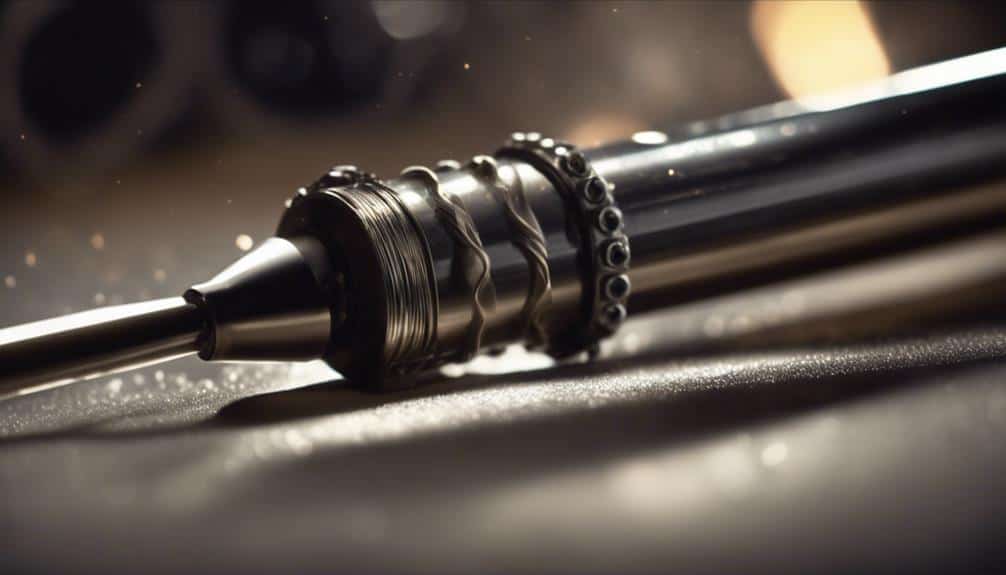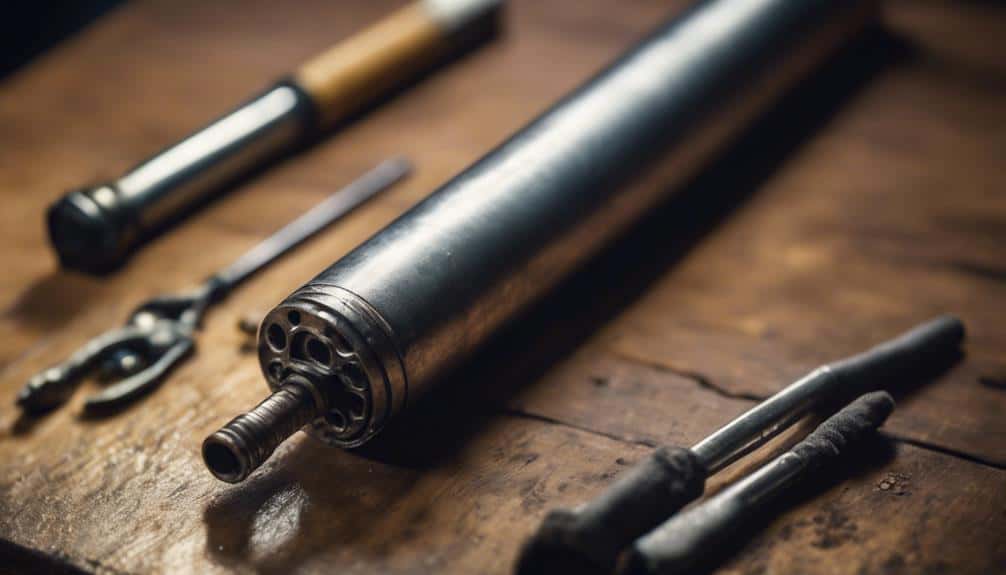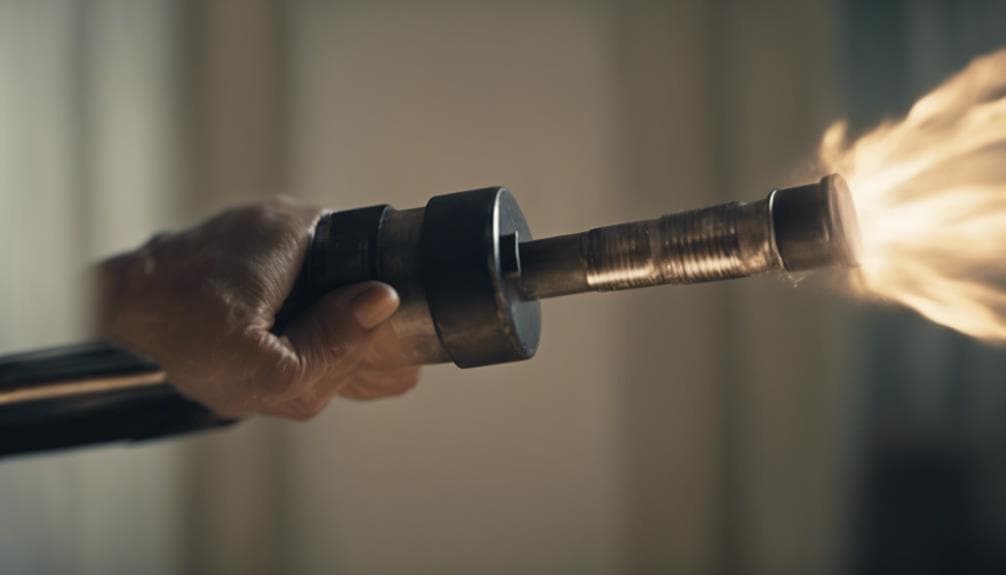
free shipping on orders over $25
We’re having a sale on all our products. Enter your email below to be notified about future sales.

Envision this: your telescopic baton, ready and waiting like a loyal companion in a thrilling spy movie. It just needs some regular TLC to stay in top shape. Kick off by cleaning it often, preventing dirt and debris from turning your baton into a metal stick. Choose a lubricant like graphite powder, for a smooth and non-sticky glide, much better than WD-40 any day. Store it safely, avoiding extreme temperatures, and you’re golden. Master a firm grip and a solid swing, practicing like a fearless action hero. Keep these tips in your toolkit, and there’s even more to discover.

To truly master the use of a telescopic baton, you must first understand its mechanics. Imagine the baton as a puzzle, with its friction-lock sections working like magic when aligned just right. It’s fascinating how modern batons have evolved with lightweight, durable materials and enhanced grip designs, improving handling in various conditions. When you’re holding it, a proper grip is your best friend. Picture yourself as a hero in a self-defense scenario, your grip firm and confident, ready to protect and defend.
The baton’s tapered design is ingenious. It creates friction at the joints, like two puzzle pieces snugly fitting together. But don’t worry, if it jams, an angled strike or a good, strong downward force will release those segments faster than you can say “abracadabra!”
Now, let’s talk about those internal components. They’re like the unsung heroes of your baton. A-rings and locking mechanisms need regular check-ups but avoid over-lubricating. You wouldn’t want your baton slipping out of your hands like a bar of soap in the shower, right?
Mastering these mechanics, with a touch of humor and a dash of patience, guarantees your baton is always ready. So, give it the respect it deserves and keep practicing until it’s an extension of your arm!
Having a firm grasp of your baton’s mechanics sets the stage for the next essential step: regular cleaning. Imagine your telescopic baton as a well-oiled machine, ready to spring into action. But dirt and debris can sneak in, clogging the works and throwing a wrench into your baton’s smooth operation. Regular cleaning is your secret weapon, keeping those internal components free from grime and functioning like a charm. It’s not just about appearances; it’s about performance. You wouldn’t want your baton to jam when you need it most, right?
Get into the habit of disassembling your baton for a good scrub. Think of it as a spa day for your baton. A specialized cleaner, like the ASP Glide Baton Lubricant & Cleaner, is your best bet—avoid using common household cleaners that might do more harm than good. Without regular cleaning, you risk facing costly repairs or even factory service trips. Establishing a maintenance schedule isn’t just smart; it’s essential. With regular inspections and thorough cleaning, you’ll extend your baton’s lifespan and keep it ready for action. So, roll up your sleeves, set that maintenance schedule, and show your baton some love.

When you’re picking the right lubricant for your telescopic baton, it’s like choosing the perfect sauce for your pasta—get it wrong, and things can get sticky! Specialized lubricants, like the ASP Glide Baton Lubricant & Cleaner, are your best bet for keeping those internal parts sliding like butter, so your baton doesn’t turn into a fancy paperweight. But if you’re feeling adventurous, give graphite powder a shot, offering a dry, non-greasy alternative that feels like sprinkling magic dust into your baton’s joints for smooth, squeak-free action!
Why choose a specialized lubricant for your telescopic baton? Well, imagine trying to run a marathon in flip-flops—not ideal, right? Specialized lubricants, like ASP Glide Baton Lubricant & Cleaner, are your baton’s running shoes, guaranteeing peak performance and longevity. Regular maintenance with these lubricants keeps your baton smooth and ready for action. They’re way better than using WD-40, which is like bringing a butter knife to a sword fight.
When you apply a generous amount of lubricant at the joints, where the end tube meets the middle tube and the middle tube meets the handle, it’s like giving your baton a spa day. This prevents wear and tear, and trust me, your baton deserves it. After applying, extend and retract the baton a few times to evenly distribute the lubricant, just like spreading peanut butter on a slice of bread—smooth and satisfying.
Here’s a quick comparison:
| Feature | Specialized Lubricant | WD-40 |
|---|---|---|
| Longevity | Excellent | Average |
| Protection | Superb | Basic |
| Smooth Operation | Guarantees | Inconsistent |
While specialized lubricants offer smooth performance for your baton, graphite powder provides an alternative that excels in certain conditions. Imagine your telescopic baton gliding effortlessly, ready for action every time—it’s possible with graphite powder, your trusty sidekick in the fight against friction. Unlike greasy oils that can turn your friction lock into a sticky mess, graphite powder keeps things running smoothly without inviting dirt to the party.
Applying this magical powder is a breeze. Just extend your baton slightly, like a knight unsheathing a sword, and gently puff that graphite powder into the joints. Picture it settling evenly, like a fine mist, ensuring your baton’s performance stays exceptional. Regularly doing this not only prevents sticking but also makes you feel like a maintenance wizard, keeping your baton in prime condition.
And let’s not forget, unlike WD-40, which might dry out faster than your patience on a Monday morning, graphite powder stands the test of time, maintaining its lubricating prowess. So, next time your baton needs some TLC, skip the oil slick and reach for the graphite powder. Your baton—and your future self—will thank you!
To keep your telescopic baton functioning smoothly and extending its lifespan, proper lubrication is vital. You’ve got to master the right lubrication techniques to guarantee it doesn’t jam up during critical moments. First things first, expand your baton fully and hold the tip upward. This helps prevent any excess lubricant from making an unwanted escape. Use a specialized lubricant, like the ASP Glide Baton Lubricant, and apply it generously at the joints between the end tube and middle tube, as well as the middle tube and handle. This guarantees all the moving parts get ideal coverage. If you’re using a 12 Inch Telescopic Steel Baton, remember that its compact size makes it easy to carry, but it still requires regular maintenance.
Once you’ve got that slick stuff in there, extend and retract the baton a few times. This simple action helps spread the lubricant evenly, guaranteeing everything inside is well-oiled. Also, pay special attention to the a-ring guides—they’re the unsung heroes of smooth operation. But remember, it’s not a one-time gig. You’ve got to regularly inspect and reapply lubricant to maintain lubrication. Otherwise, neglect could lead to costly repairs, and who wants that? So, keep your baton in tip-top shape, and it’ll be ready for action whenever you need it. After all, nobody wants a sticky situation, right?

When you’re handling a telescopic baton, gripping it properly is like giving a firm handshake—secure but not too tight, to keep control without straining yourself. Imagine deploying it with the finesse of a magician pulling a rabbit from a hat—smooth and confident, without any clumsy flailing that might lead to unexpected comedy. By mastering these techniques, you’ll not only keep your baton in tip-top shape but also guarantee you’re ready for any situation, like a superhero with a trusty sidekick!
Grasping a telescopic baton correctly is essential for maintaining control and ensuring safety during its use. You want to make sure you’ve got the proper grip techniques down pat. Keep a firm grasp with your dominant hand near the handle, which helps maintain control during deployment. Wrap your fingers snugly around the baton and stabilize it with your thumb against your palm for a secure hold. It’s like giving your baton a reassuring handshake!
You don’t want any surprises, so hold the baton close to your body when it’s not in use. This way, you’re always ready for action and avoid accidental deployment. When it’s time to strike, use your wrist for quick, precise movements rather than swinging wildly, like you’re auditioning for a baton-twirling competition.
| Grip Technique | Benefit |
|---|---|
| Dominant hand hold | Control during deployment |
| Fingers wrapped firmly | Secure hold and stability |
| Thumb against palm | Added grip security |
| Wrist motion strikes | Accuracy and control |
Practicing these techniques regularly will develop muscle memory and boost your effectiveness in real situations. Remember, the more you practice, the less likely you’ll be caught off guard.
Ensuring your telescopic baton’s safe deployment is essential for effective use and minimizing risks. You don’t want a baton mishap when you need it most! First, always hold the baton with the tip facing upward during deployment. This prevents accidental release and keeps things running smoothly. When it’s time to deploy, use a sharp, angled strike on a solid surface. This breaks the seal between the tapered sections, ensuring the locking mechanism clicks into place. You’ll feel like a pro when it secures perfectly! Consider pairing your baton with a heavy-duty nylon holster for secure carrying and quick access.
Hold the baton firmly and keep it close to your body. This gives you better control and keeps it from being knocked away, especially in those tense situations. Practicing downward force while squatting helps secure the lock, making sure it’s ready for action. Familiarizing yourself with the locking mechanism is key. A well-locked baton is a reliable baton!
Here’s a quick checklist to remember:
Evaluating your telescopic baton’s performance is essential to guarantee it’s always ready for action. You know that familiar feeling when you need your baton to perform flawlessly, but it decides to act up instead. To prevent such mishaps, pay close attention to the lubrication and locking mechanism. Regularly apply a specialized lubricant, like ASP Glide Baton Lubricant, to the joints—between the end tube and middle tube, and the middle tube and handle. This not only assures smooth performance but also keeps those pesky malfunctions at bay. Speaking of security, the disable pin is a valuable feature found in products like the Repeller Stun Baton, which prevents unauthorized use if the baton is taken away. Now, about that locking mechanism—it’s imperative. You want it to lock securely during use, right? Try practicing proper striking techniques. These not only help maintain the baton’s responsiveness but also make you feel like a self-defense ninja. Inspect your baton regularly to catch any wear and tear before it becomes a problem. Familiarizing yourself with its components and maintenance needs isn’t just smart; it’s practically a superpower for keeping your baton reliable.

When it comes to storing your telescopic baton, in between uses, location matters. You want to keep it in a safe, dry place to avoid moisture damage and corrosion. Nobody likes a rusty baton, right? Make sure it’s fully collapsed and locked in its retracted position. This little step helps maintain its structural integrity and prevents any accidental deployments. Imagine the surprise of an unexpected baton pop—yikes! Consider storing it alongside other self-defense tools like an 80 Million volt Stun Bat with Flashlight for thorough safety. Extreme temperatures? No, thank you! Keep your baton away from excessive heat or cold, as these can mess with the materials and the locking mechanisms. You don’t want your baton turning into a floppy noodle when you need it most. Also, avoid placing heavy objects on top; they might bend or damage its shape, and nobody needs a wonky baton. Regular inspections are key, ensuring your baton’s always ready for action. Don’t be shy—give it a good look-over now and then. Let’s make sure it’s in tip-top shape. Remember, storing your baton correctly isn’t just about putting it away; it’s about taking care of it. Here’s a quick recap:
While owning a telescopic baton can enhance personal security, it’s vital to understand the legal landscape that comes with it. You’ve got this sleek, extendable tool that makes you feel like a secret agent, but hold up! Legal considerations are at play. Depending on where you live, simply carrying a baton might require a permit. Crazy, right? That’s why you’ve gotta check your local laws before thinking you’re the next crime-fighting superhero. Similarly, self-defense tools like keychain weapons also require awareness of legal restrictions, as they vary by state and can greatly impact your ability to carry them. Security personnel often have different rules for baton use, which don’t always apply to folks like you and me. Compliance with these regulations is vital unless you fancy a surprise chat with the local police. And let’s talk about improper use for a second. Waving a baton around like you’re in an action movie could land you in hot water. Legal consequences, such as assault charges, are no joke.
Imagine pulling it out to scare someone off, only to find yourself in a courtroom trying to explain your intentions. Yeah, not fun. So, stay informed about the legal implications of owning and using your baton. It’ll keep you out of trouble and guarantee your trusty tool is ready for action when you really need it.

When it comes to handling your telescopic baton like a pro, you’ve got to understand its locking mechanism, making sure those sharp, angled strikes on a hard surface are second nature to you—just like brushing your teeth, only a bit more impactful! Regular practice with your grip and stance is your secret weapon, helping you strike with laser accuracy while avoiding those awkward moments of accidental disengagement mid-action, which could be as embarrassing as slipping on a banana peel in front of a crowd. It’s also important to be aware of the laws & restrictions associated with carrying and using a baton in your area, ensuring your actions are always compliant. And don’t forget, knowing your baton’s ins and outs, like how to clean and lubricate it, is key to keeping it operating smoothly, because nobody wants a squeaky baton—it’s not a haunted house prop!
Mastering effective baton handling techniques can considerably enhance your proficiency and confidence. You know, it’s not just about swinging a piece of metal around. It’s about precision, control, and making certain you’re ready for anything. Holding the baton upside down when striking can seem odd, but it guarantees a secure extension. Imagine how secure you’ll feel when your baton snaps into place exactly when you need it! Quick deployment is vital, so always keep a close grip. It sounds simple, but it makes all the difference when seconds count.
Embracing these techniques transforms you from just a baton owner into a confident user, ready to handle whatever comes your way. So, get practicing and turn handling your baton into second nature!
After honing your handling techniques, it’s time to focus on mastering the locking mechanisms of your telescopic baton. Understanding how these mechanisms work is essential for your baton to perform flawlessly. Envision you’re in a high-stakes situation, and a malfunction could spell disaster. You don’t want that, right? Your grip and the downward force while squatting can make all the difference in locking efficiency.
Now, those tapered sections—they’re tricky but vital. They create friction that you need to overcome. Visualize this: angled strikes are your best friends here, effectively releasing the baton when needed. It’s like a secret handshake between you and your baton! Remember, keep it upside down to prevent accidental disengagement during strikes. It’s a small tip, but it makes a huge difference.
Regular maintenance checks are your baton’s best insurance policy. Ignore them, and you might end up sending it back to the factory, and that’s no fun. Practicing sharp, stabbing strikes on a hard surface helps disengage sections and keeps you ready for action. Stay sharp, stay ready!
| Emotion | Action | Outcome |
|---|---|---|
| Confidence | Mastering techniques | Preparedness |
| Surprise | Tapered sections mastery | Efficient usage |
| Satisfaction | Regular maintenance | Reliable baton |
Choosing the ideal baton model can greatly enhance your effectiveness and safety in various situations. When you’re selecting the ideal baton model, think about how it fits into your life. You want something compact when retracted, like the Monadnock Autolock Baton, which is perfect for slipping into a bag or belt without being a bother. Autolock models are a game-changer, especially in moments when you need to act fast. Imagine you’re in a tense situation, and bam! Your baton is ready to go with just a flick. It’s like having a superhero tool at your fingertips, minus the cape. If you’re interested in personal security, consider investing in a Door Stop Alarm for additional safety at home.
Your expandable baton isn’t locking due to improper baton maintenance tips, locking mechanism issues, or ignoring baton safety precautions. Guarantee it’s clean, lubricated correctly, and check for wear. Regularly practicing proper handling techniques will improve functionality.
Expandable batons are effective for self-defense due to their durability and ability to create distance from an attacker. However, guarantee you understand local legal considerations and get proper training to maximize their effectiveness and avoid excessive harm.
Feel the power in your grip with a 21 to 26-inch baton. This length balances reach and maneuverability, maximizing self-defense effectiveness. Prioritize personal safety by ensuring your baton’s legal and comfortable for you to wield confidently.
To use a friction lock baton effectively, understand its locking mechanisms. Extend it with force; tapered sections create friction. Avoid lubricating it. Use proper maintenance techniques to guarantee baton materials stay in top condition for reliable performance.